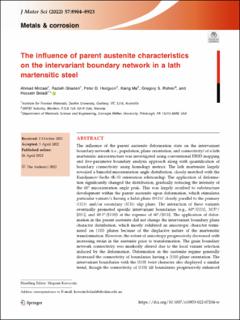| dc.contributor.author | Mirzaei, Ahmad | |
| dc.contributor.author | Ghaderi, Razieh | |
| dc.contributor.author | Hodgson, Peter D. | |
| dc.contributor.author | Ma, Xiang | |
| dc.contributor.author | Rohrer, Gregory S. | |
| dc.contributor.author | Beladi, Hossein | |
| dc.date.accessioned | 2022-10-24T06:56:29Z | |
| dc.date.available | 2022-10-24T06:56:29Z | |
| dc.date.created | 2022-05-15T15:21:51Z | |
| dc.date.issued | 2022 | |
| dc.identifier.citation | Journal of Materials Science. 2022, 57 8904-8923. | en_US |
| dc.identifier.issn | 0022-2461 | |
| dc.identifier.uri | https://hdl.handle.net/11250/3027716 | |
| dc.description.abstract | The influence of the parent austenite deformation state on the intervariant boundary network (i.e., population, plane orientation, and connectivity) of a lath martensitic microstructure was investigated using conventional EBSD mapping and five-parameter boundary analysis approach along with quantification of boundary connectivity using homology metrics. The lath martensite largely revealed a bimodal misorientation angle distribution, closely matched with the Kurdjumov–Sachs (K–S) orientation relationship. The application of deformation significantly changed the distribution, gradually reducing the intensity of the 60° misorientation angle peak. This was largely ascribed to substructure development within the parent austenite upon deformation, which stimulates particular variant/s having a habit plane (011)α′ closely parallel to the primary (111)γ and/or secondary (11¯¯¯1)γ slip plane. The interaction of these variants eventually promoted specific intervariant boundaries (e.g., 60°/[111], 10.5°/[011], and 49.5°/[110]) at the expense of 60°/[011]. The application of deformation in the parent austenite did not change the intervariant boundary plane character distribution, which mostly exhibited an anisotropic character terminated on {110} planes because of the displacive nature of the martensitic transformation. However, the extent of anisotropy progressively decreased with increasing strain in the austenite prior to transformation. The grain boundary network connectivity was markedly altered due to the local variant selection induced by the deformation. Deformation in the austenite regime generally decreased the connectivity of boundaries having a {110} plane orientation. The intervariant boundaries with the {110} twist character also displayed a similar trend, though the connectivity of {110} tilt boundaries progressively enhanced with increasing strain. The former was closely matched with a decrease in the population of 60°/[110] intervariant boundaries with the strain. The current findings suggest that the intervariant boundary network of lath martensite can be manipulated through changes in the parent austenite deformation state which, in turn, can be used to enhance key final product properties such as toughness. | en_US |
| dc.language.iso | eng | en_US |
| dc.publisher | Springer | en_US |
| dc.rights | Navngivelse 4.0 Internasjonal | * |
| dc.rights.uri | http://creativecommons.org/licenses/by/4.0/deed.no | * |
| dc.title | The influence of parent austenite characteristics on the intervariant boundary network in a lath martensitic steel | en_US |
| dc.title.alternative | The influence of parent austenite characteristics on the intervariant boundary network in a lath martensitic steel | en_US |
| dc.type | Peer reviewed | en_US |
| dc.type | Journal article | en_US |
| dc.description.version | publishedVersion | en_US |
| dc.rights.holder | Copyright: The Author(s) 2022 | en_US |
| dc.source.pagenumber | 8904-8923 | en_US |
| dc.source.volume | 57 | en_US |
| dc.source.journal | Journal of Materials Science | en_US |
| dc.identifier.doi | 10.1007/s10853-022-07204-w | |
| dc.identifier.cristin | 2024694 | |
| cristin.ispublished | true | |
| cristin.fulltext | original | |
| cristin.qualitycode | 1 | |

